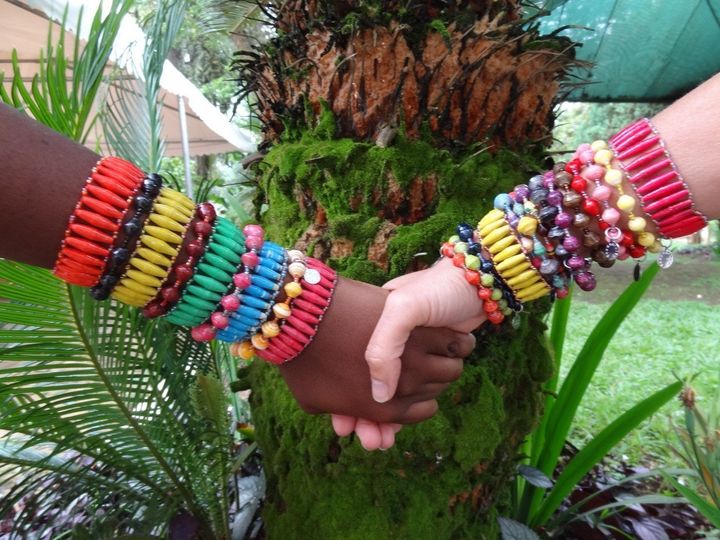
We just heard two inspiring, heart-wrenching, gut-churning, funny, amazing life stories from two Ugandan women, Joan and Teddy, who lifted themselves out of dire poverty and suffering by making and selling paper beads.
The poverty is huge. For example, Millie lives on $1 a day earned from crushing rocks in a quarry, and she has asthma. This is enough money for one meal every day for her whole family. She lives in a 4x7 hut with her six children, two of whom are AIDS orphans she has adopted. They have no water, no electricity, and no possessions. It is so small that one person is appointed to say when everyone should roll over at night.
At least, that was how Millie was living. Now she has a small house of her own, financed by a brick-making business she runs. And this was made possible because she learned how to roll beads out of strips of recycled paper.
How did this happen? Some years ago friends of ours went to Uganda, Africa. Dr. Charles Steinberg was there to teach the local doctors how to use AIDS medicines. Before the family left the U.S., he, his wife Torkin, daughter Devin, and friend Ginny sat together in prayer. "We said we were tired of talking about how hard the world is and asked for something to do. This very clear intention was voiced within the context of prayer and sacred commitment," Torkin told us. "We never dreamt it would manifest through paper beads!"
A few months later, the four of them were in Kampala, the capital of Uganda. On a chance encounter in a Kampala slum, on their way to visit an AIDS patient, the women met Millie, who was rolling paper beads. She told them that she had no real market to sell them. They bought a few of her necklaces and, as they wore them, found that many people admired and wanted them. "So we went back to find this woman and discovered a group of her friends who also made beads. We bought about a 100 necklaces. We came back to the U.S. for the summer and began to sell them to friends and at craft fairs."
The beads began to generate interest, including a magazine article. They realized there was a market, but that most importantly it was about the story and the heartfelt desire to help those in need. One man who loved the beads so much and wanted to give money to the beaders offered $200 for a necklace that was on sale for $20.
The women who become beaders all live in slums in Kampala. Many of them are HIV positive, malaria is rampant, and nearly all are raising, alongside their own children, other children they have adopted from some of the 1.1 million AIDS orphans in Uganda. At least 95 percent of the beaders are women and 40 percent are refugees, living in huts as small as Millie did with just enough room for them to lie down. All have multiple life challenges. As Torkin says, "It was very humbling to work with these people who struggle so deeply yet also know how to lift themselves up, to laugh, sing and have joy. In a song they wrote there is one line that remains in my heart: 'We dance while we are suffering.'"
A beader who joins the BeadForLife program gets paid twice a month for their beads and they have to open a savings account. The program is 27 months long and the beaders all receive health care, optional family planning, and business training. By month 20, BeadForLife tops up their savings to $800, enough so that each one can begin their own business to support themselves after the bead-making program has finished. One woman, who used to wash prostitutes' clothes in a nightclub, now owns a nightclub. There are restaurants, chicken farms, dry good stores, and clothing stores, all begun this way.
Beads can be bought online, but because of the power of the beader's stories, most beads are sold through BeadParties hosted in people's own homes. This is how everyone can help. Many times 2-3 women do this together and it is really fun. And most importantly, the beads are beautiful -- vibrant colors and different shapes.
This week and next, between April 9-23, Beadforlife is hosting The Opportunity Tour, with events in Washington D.C., Pittsburg, New York, San Francisco, and Los Angeles. Join Joan and Teddy, hear their stories, and buy beads. Get all the details at: www.BeadForLife.org.
Do share stories of people getting out of poverty. You can receive notice of our blogs every Tuesday by checking Become a Fan at the top.
Join our Be The Change Meditate e-Conference that will uplift and inspire you. Thirty eclectic meditation teachers, including Marianne Williamson, Congressman Tim Ryan, author of Mindful Nation, Sharon Salzberg, Robert Thurman, Gangaji, Joan Borysenko, Seane Corn, neuroscientist Richie Davidson who proves how meditation affects the brain, Roshi Joan Halifax, Tara Stiles, and us, Ed and Deb Shapiro, authors of the conference companion book, BE THE CHANGE: How Meditation Can Transform You and The World. Expect your life to never be the same again!
For more information: www.edanddebshapiro.com.
For more by Ed and Deb Shapiro, click here.
For more on emotional wellness, click here.